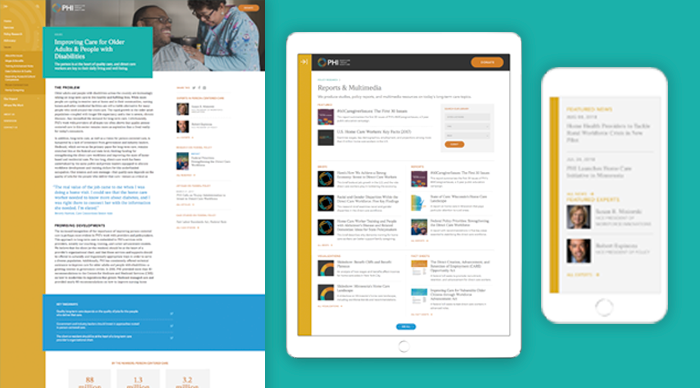The Paraprofessional Healthcare Institute (PHI) is the leading direct care policy and advocacy nonprofit in America, transforming eldercare and disability services by fostering dignity, respect, and independence—for all who receive and provide care. In a workforce that is represented by a majority of women and people of color, PHI works as a tireless advocate for equity for direct healthcare workers. They also promote economic opportunity by increasing high-quality direct care jobs. And having just completed a strategic planning process, PHI needed to center the nonprofit’s policy and advocacy website design on its new brand strategy.
Specifically, PHI wanted their new digital strategy to help the nonprofit raise awareness of the key issues, engage a diversity of audiences, create unity across their work streams and engage a diversity of audiences to increase PHI’s policy leadership, raise issue awareness, make their research and support tools more accessible.
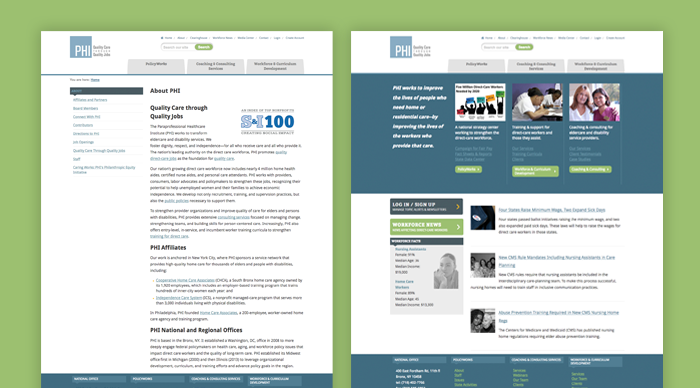
A Content-Heavy Nonprofit Website Design Creating Confusion
PHI’s existing website had several key problems that were holding them back. First was that the nonprofit’s website design no longer reflected their new strategic model. Rather than making it easy to understand the issues and PHI’s strategy to address them, it forced people into old, disconnected organizational silos. Second, PHI had just completed a rebranding, leaving them with a website design at odds with their identity. And third, like many content-heavy nonprofit websites, PHI’s had become cluttered. Confusing navigation and poor website search made it hard for people to find what they want and overly text-heavy pages failed to keep users engaged. And because they are a policy and advocacy nonprofit working in a specialized sector, PHI’s website used jargon rather than communicating in accessible terms.
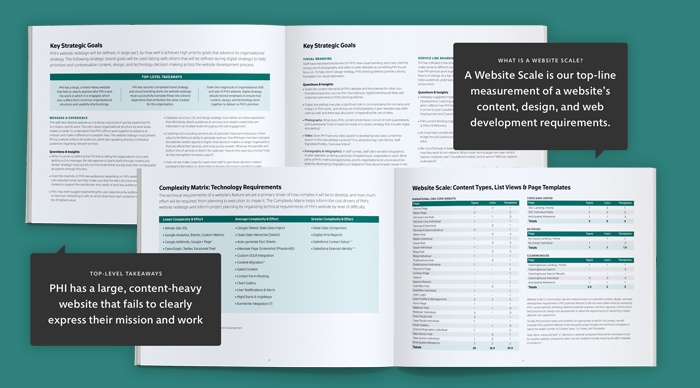
Starting With Discovery to Design a Strategic Nonprofit Website
The nonprofit’s team, of course, had a long list of things that they wanted to change, improve, and add so that their new policy and advocacy website design would make a bigger difference in their mission. They just didn’t know where to start or what accomplishing their goals would entail. To help everyone make sense of it all, we started with a dedicated strategic discovery phase to understand the current website, establish clear goals for a new website design, and create detailed requirements to achieve them.
First, we audited the nonprofit’s website, content, and technology systems. We then led digital strategy workshops with PHI’s leadership to understand their operations, identify pain points, explore solutions, and prioritize needs. We then developed a strategic plan for policy and advocacy nonprofit website design that focuses on what matters most—detailing the strategic, creative, and technical requirements with a roadmap and budget that aligned PHI’s team and ours to support their new brand strategy.
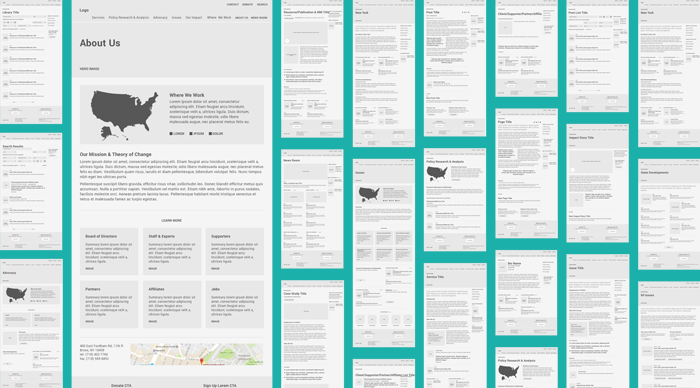
Nonprofit UX Design That Eliminates Organizational Silos and Supports Brand Strategy
PHI is a complex healthcare policy and advocacy nonprofit, providing a wide range of services that support and strengthen the direct care sector. Unfortunately, PHI’s fragmented website was siloed and failed to support their breadth and depth of services. The nonprofit’s website is also content-heavy with resources that need to be accessible and engaging to support their policy and advocacy work.
We also needed to make sure that the design of such a content-heavy policy and advocacy website made sense to real people. To design a more useful experience, we started with user research to give us valuable perspective we can’t have on our own. Analytics analysis deepened our understanding of how people were using PHI’s website, giving us an evidence-based foundation to design a new user experience.
As with all nonprofit websites, our UX strategy stayed focused on raising issue awareness. We designed a site structure that bridges PHI’s silos—organizing ideas by issues, geography, and services; and framing the issues within broader social context to focus on the mission. The result paints a clear picture of who PHI is, what they do, and why they matter—and makes their volumes of policy and advocacy resources readily available.
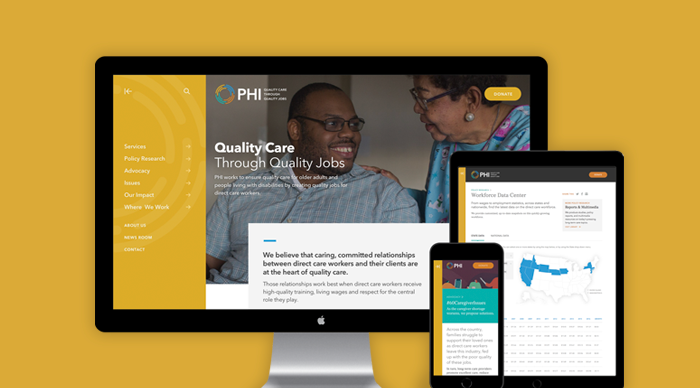
Nonprofit Policy and Advocacy Website Design That’s as Engaging as it is Useful
Designing brand experiences for certain research-focused policy and advocacy nonprofits presents an interesting challenge. By definition, they rely on research that’s often wonky and technical. They speak to subject matter experts and policymakers who are looking for evidence-based expertise. At the same time, every policy and advocacy nonprofit’s work is about social impact. It’s driven by values, and is ultimately about the impact on real people and the planet.
To help PHI balance these two essential aspects of their brand, we designed a website that’s both structured and dynamic. Bold brand colors set the tone within rhythmic grids that keep PHI’s long-form research content engaging. It uses authentic, representative imagery that embody the dignity and compassion that are the heart of the direct care workforce. The results are a website design for a policy and advocacy leader that both creates emotional connections to the direct care issues and people and communicates the rational rigor needed to lead on them with great credibility.
Policy and Advocacy Nonprofit Website Design That Elevates the Issues and the Experts
Central to PHI’s digital strategy is helping audiences understand complex issues facing the direct care workforce. To advance the nonprofit’s leadership at the national, regional, and state levels, we designed PHI’s website with a combination of editorial design techniques and best practices in digital storytelling for nonprofits.
Design engages both expert and lay audiences by delivering top-level takeaways and inviting deep dives into PHI’s content. PHI’s website follows through on our goal of by elevating PHI’s expertise with a library center of PHI’s reports, briefs, and multimedia—and a dedicated National Direct Care Workforce Resource Center that makes it easy for experts to leverage PHI’s research.
The result positions PHI as the leader of one of the fastest-growing sectors of the healthcare industry, delivering a wealth of expertise, insights, resources, and results. It also embodies a tireless advocate and educator for the direct care workforce, a rigorous policy research expert, and a strong voice who raises awareness.
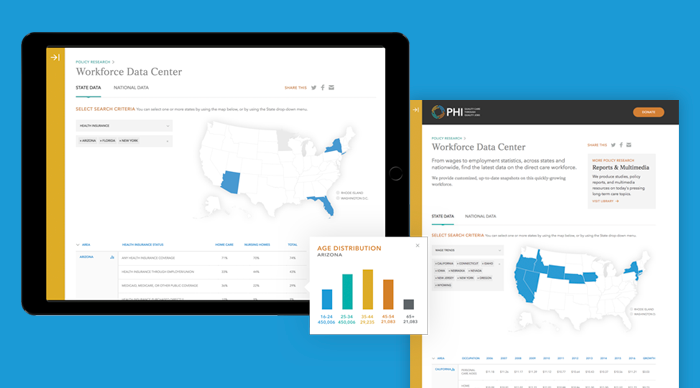
Designing Data Visualization to Deepen Understanding of the Direct Care Workforce
As the leading national expert of the direct care sector, PHI supports the work of policy and advocacy efforts with large-scale, data-driven research on wages and employment statistics for every state and nationwide. Drawing on our team’s expertise in designing data visualization indexes for nonprofit issues such as health equity, the global environment, and the economic impacts of climate change, we turned PHI’s tabular data sets into a dynamic Workforce Data Center.
The new digital data visualization tool contains one of the most comprehensive data sets in the world on the direct care workforce. The interactive data tool empowers users to create customized, comprehensive, up-to-date snapshots that explore issues from race, gender, age, and employment status, to earnings, wage trends, and insurance at the state and national levels.
The Results
“Constructive is fantastic to work with, and our entire collaboration process reaffirmed that we had chosen the right partner. They’re personable and bring a team of experts in different aspects of branding and website development to our relationship. They ask hard questions that force us to think through things we wouldn’t have otherwise. They’re thorough and solutions-oriented. They’re able to both answer high-level strategic questions and focus on executing the details. And they met our deadline, which is rare in website redesigns!” – Robert Espinoza, Vice President of Policy
—————————
Learn More About Our Work
Get an up-close and detailed look at this project in our visual case study or explore Constructive’s design for healthcare & social services nonprofits.




